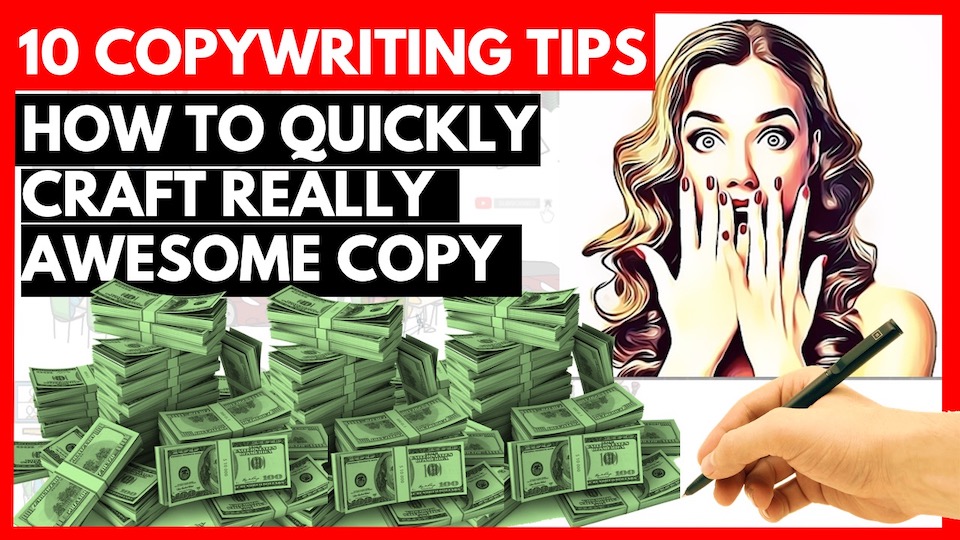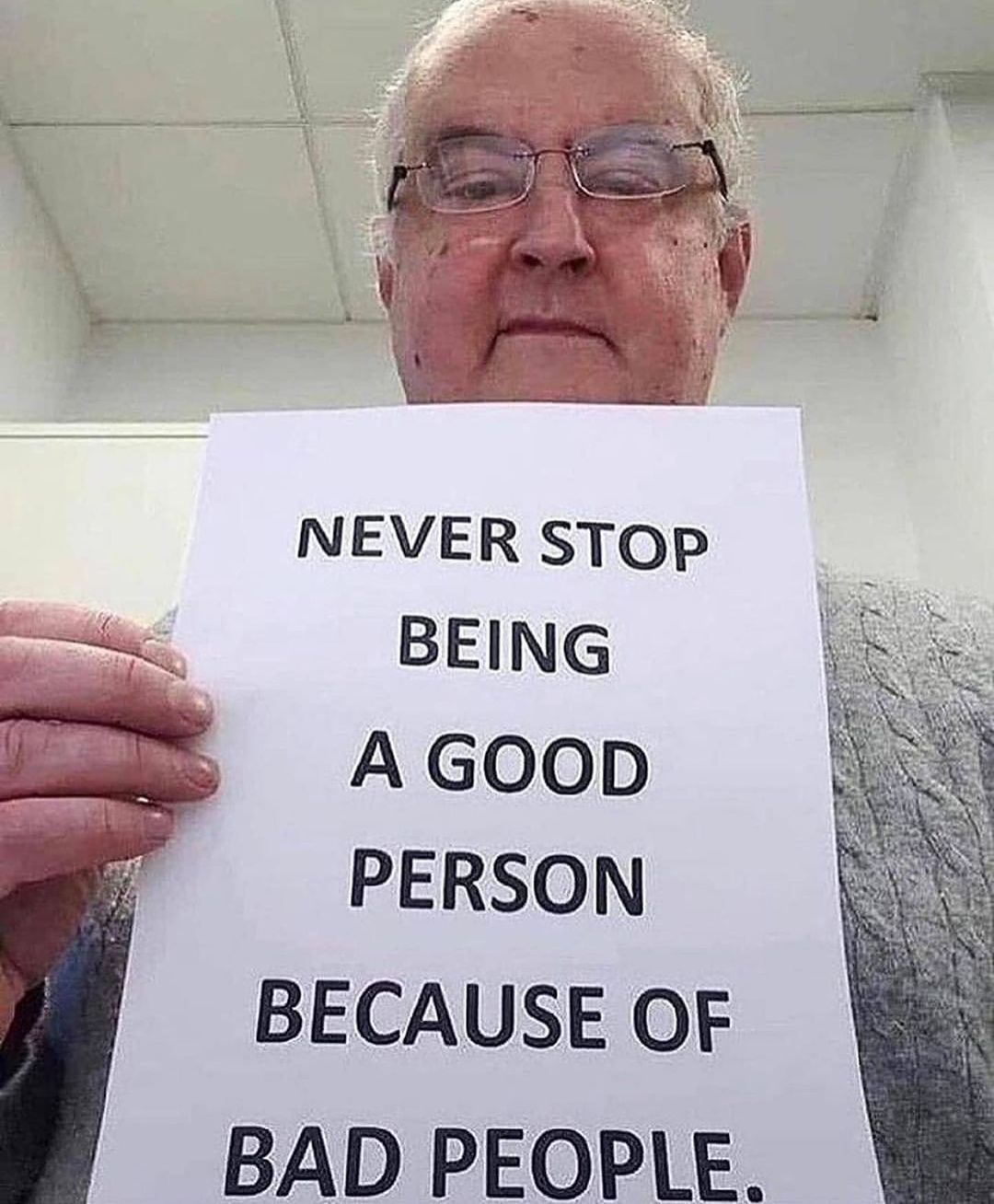So you want to get more traffic? Generate more leads? Make more sales?
Without increasing your ad spend?
Without spending too much time writing ads?
Watch this video till the end, and you’ll discover some closely guarded secrets the top-performing copywriters use, to command ridiculously high fees, and drastically grow seemingly any business on demand.
(If you prefer to read, scroll down and read the text version below.)
Here’s why I’m sharing this:
Not too long ago I met a bunch of fellow digital marketers in a flesh. Some unusual bunch.
Most people out there don’t understand what kind of business they’re operating.
Some people think they’re just a bunch of spoiled brats who inherit their parents’ wealth. Maybe ‘coz of their lavish lifestyle at a very young age.
Some thought they’re doing something downright illegal. Maybe it’s human nature to have wild imaginations of something they’re not familiar with.
The truth is, they’re just some normal everyday people who’re lucky enough to spot some trends early, and are actually bold enough to take action.
Anyway, we’ve known each other for quite some time but never got the chance to meet face to face and hang out physically before that.
So we had fun. Hanging out. Goofing around. Sharing ideas. Exchanging trade secrets, and stuff.
Once in a while, we do the usual stuff like movies, shopping, and dining. And sometimes the unusual stuff besides online business, like working out, sparring, vacation…
One day, while I’m on holiday in Hong Kong with my family…

One day, while I’m on holiday in Hong Kong with my family, one of ‘em called.
This guy explained that they’re in the middle of a launch, got all excited, got burned out, sleepless nights… yada yada yada…
He’s beating around the bush.
But actually, they’re missing one thing: the sales copy!
Damn. I asked him “how come?”
Apparently, the person in charge of that couldn’t deliver. She got an emergency but didn’t inform us early.
So he called me to help ‘em with the sales copy. And they need it by tomorrow!
Obviously I was reluctant, ‘coz I’m in the middle of a holiday overseas, with my wife and kids.
I knew my wife would be upset, since our rule is don’t bring any work to a vacation. And I didn’t even bring my laptop!
So they talked me into it, they’d pay in full, no member’s price. They even added a big rush fee for their trouble.
They were practically begging. And I finally gave in.
So there goes my one night of vacation.
And here comes the pain.
Want to know how it goes?
Stay tuned till the very end. You might find some valuable insights from this story.
It’s a startling statistic.

According to WordStream (2018), the average click-through rate (C T R) on Facebook ads across all industries is 0.9%.
Like if 100 people see your FB ad, only 1 person will click to learn more.
On Google AdWords?
1.91% on the search network. And 0.35% on the display network.
But that’s just people showing interest.
Can you guess how many interested people actually turn into buyers, customers, or clients?
Statistics say the average sales conversion rate online is 1.5%. Like in every 100 interested people, only 1 or 2 actually buy.
So on average, out of 10,000 people seeing the ad, you only get 1 buyer.
Just like most businesses fail, most advertisers lose money.
If you want to make more profit, you need more qualified traffic, better marketing materials, better sales presentation, and better follow-up .
And for all that, you need a really awesome copy.
But how do you craft one and spend less time doing so?
I mean, we don’t have all day just writing copy. We got something else to do.
Many clients I serve reported that they used to spend all week trying to create even a short simple ad, but they still came back empty-handed, and lost money after all those efforts.
So what can you do?
Here are 10 actionable tips you can use right now to come up with a really awesome copy faster.
Tip #1: Do your research first
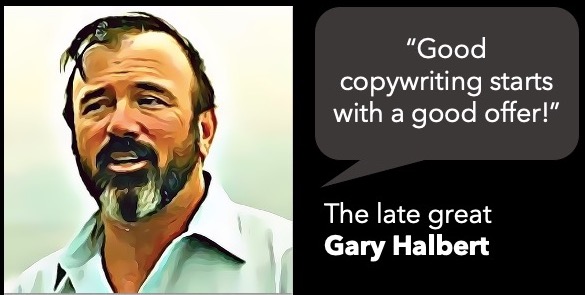
The late great Gary Halbert once said: “Good copywriting starts with a good offer.” I would add that, “a good offer starts with a good understanding.”
Now I know what you’re thinking.
Research takes a lot of time, but hear me out.
Don’t ever think market research is a waste of time.
It takes very little time to know the essentials, and you can be the top player in this game if you’re willing to go just a little extra mile.
Writing copy with no materials takes longer, and makes less money.
It’s like cooking with no or not enough ingredients in place. You have to search the whole kitchen, or go to the grocery to get something.
You simply can’t write good ads fast if you don’t have enough materials.
This topic of research alone deserves a dedicated video of its own.
But what should you study before writing copy?
Study the market, the audience, and the thing you wanna sell.
Understand the demand and current trends of that market. What’s hot right now, what’s phasing out, and what’s the next big thing? Who’s who in the market? Who’s your direct and indirect competition, and who can become your allies?
Understand the ideal customer. Who are they? What are their demographics, their geography, their psychographics, and sociographic? What are their dreams and desires, their pains and gains, their fears, and frustrations?
How’s their typical day? Where do they hang out? What do they see? What do they hear? How do they feel? What do they say? What do they do? What keeps them up at night?
Understand the product/service/offer. What are the strengths, the weaknesses? The opportunities, the threats? (SWOT analysis) What/who are your direct competition? Indirect competition? Why you, why yours, why not them, why not theirs? What’s your USP?
How do you know all this, and where do you get the info from?
Many ways to find out.
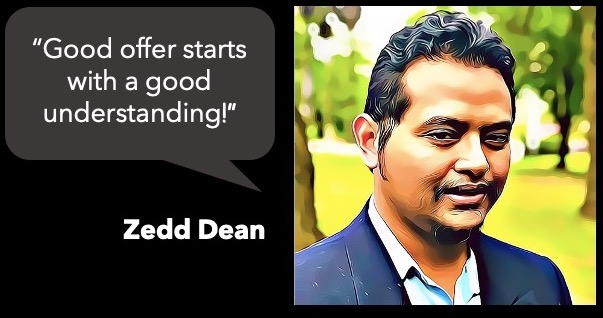
Do some data mining. Go to the marketplace like Amazon, eBay, Clickbank, Alibaba, Etsy, even AliExpress (depending on your niche).
Look for the top-selling stuff. Read the reviews. Take note of why people like something, hate something, and how can it be improved.
Also, find niche forums and learn their language.
Compile all this info in one file. The more you learn, the more you earn.
Interview your existing customers. Ask them why they bought from you. Interview the not-yet-customers, and ask them why they didn’t buy. Even Interview your competition’s clients. Learn why they bought what they bought.
Although what people say is not exactly what they do, there’s value in their input and at least the way they speak. Use their voice in your copy.
More importantly, study their behaviors, also through data mining.
The more you learn, the more you earn.
Keep all this in a dedicated file. Do this with each and every product and service you offer, or anything you ever wanna promote.
Tip #2: Start with an outline
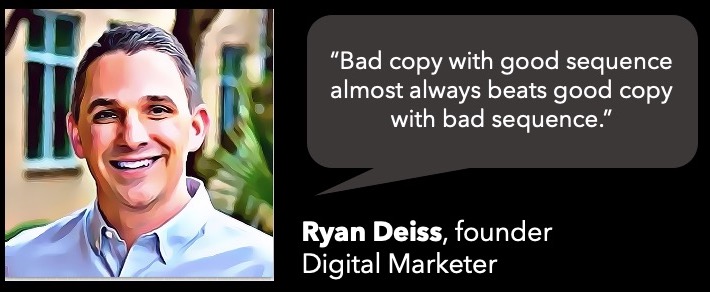
A piece of advice from Ryan Deiss, the founder of Digital Marketer: “Bad copy with good sequence almost always beat good copy with bad sequence.”
Now sequences can be many things. But come to think of it, that’s what an outline would give you; a sequence in a given discourse (how to start an essay/salesletter/live presentation, how to progress, how to close, etc.)
Never start your copywriting from scratch without an outline (unless you have tons of experience under your belt and the results to back it up).
In copywriting, decent elements with solid structure almost always outperform solid elements with decent structure.
By elements, I mean the headline, the bullets, the story, the proof, the triggers, the call-to-action, etc. And by structure, I mean the way you organize all those elements into one cohesive unit as a sales presentation/argument.
Outlines are useful not just for long-form copy like salesletters, video sales letters (VSL), and webinars, but also for short copy like emails, Adwords, FB ads, InstaAds, and explainer videos.
Use a proven structure, and then experiment with another next time around.
Some structures that work wonders for me to this day are the Big AIDEEA, the Irresistible Offer, the 12-point salesletter, the 21-step salesletter, the 35-micro-step sales video, and the Proven Presentation Webinar.
Tip #3: Use proven formulas
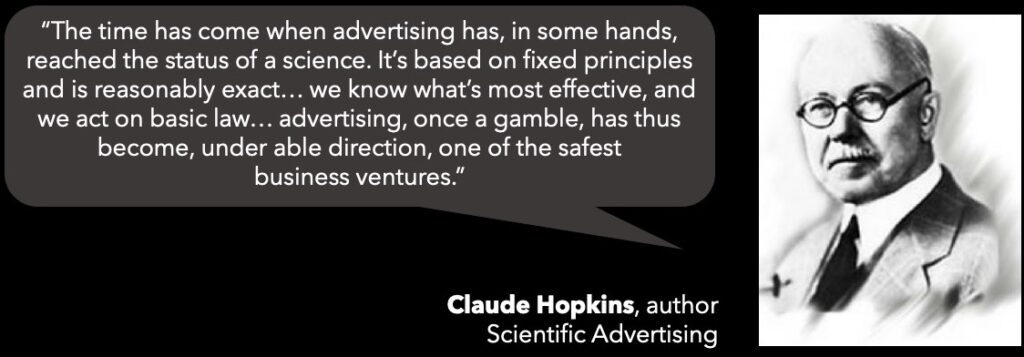
In his book Scientific Advertising, the legendary ad man Claude Hopkins fantabulously put it this way:
“The time has come when advertising has, in some hands, reached the status of a science. It’s based on fixed principles and is reasonably exact… We know what’s most effective, and we act on basic law… Advertising, once a gamble, has thus become, under able direction, one of the safest business ventures.”
After you have the data (read: ingredients) and the structure (recipe), get your formulas ready.
There are so many copywriting formulas out there on so many levels. Don’t reinvent the wheel.
We have the element formulas for the headlines, the bullets, the CTAs, the testimonial formulas, etc. We also have the structural formulas (outlines), including for the salesletter, sales vids, webinars, FB ads, Google ads, contents, etc.
This time around, I’m referring to formulas for the small elements and mini-structures, instead of the outlines.
Some classic mini-structure formulas are PAS, FAB, QUEST, AIDA, and UPWORDS.
Some classic element formulas are the “yeah sure” formula, the “so you can” formula, and the “how to yay without boo” formula.
Don’t reinvent the wheel.
Make good use of them.
By the way, if you want me to do some videos on these proven formulas, write it down in the comment below.
Tip #4: Use proven tools

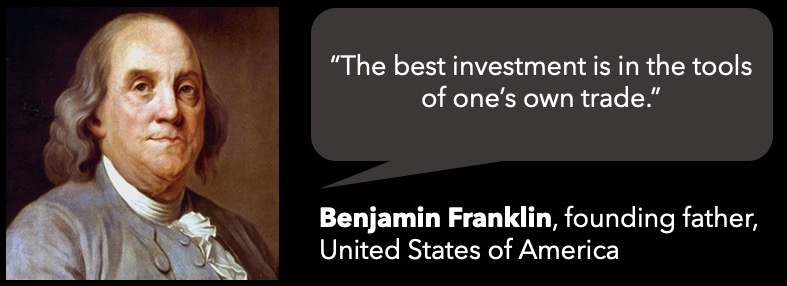
According to the late Apple co-founder, Steve Jobs: “You cannot mandate productivity. You must provide the tools to let people become their best.”
Benjamin Franklin used to say: “The best investment is in the tools of one’s own trade.”
Don’t bring a baseball bat to a gunfight.
To write really awesome copy the smart way, make full use of all the wonderful tools.
Want to know the exact language your prospects use to find solutions, which is important for copywriting and SEO?
Use Adwords’ Keyword Planner. Find out the keywords and phrases with a high average monthly search.
This shows what words/phrases they type on Google to find stuff.
Have problems coming up with a powerful headline? Use AMinstitute EMV and CoSchedule Headline Analyzer to create one.
Body copy too bland? Use the Power Word list and the Bucket Brigades to sprinkle around words that command influence.
Loss of words when writing copy? Use thesaurus.com to find the right words.
Not sure about your grammar? Use Grammarly to check and correct your copy.
Want to add some sound bytes so your audience gets glued? Use RhymeZone for a copy that rhymes.
Writing too slow because you can’t find the time and space to access your work? Use Google Docs, Dropbox or EverNote to store your writing work.
This way you can access your work and work on it on any device as long as you have a decent internet connection.
This allows you to make progress faster since you can work in your most optimal setting and also work on the go.
It might not seem much, but that alone makes a huge difference.
Tip #5: Use proven templates

To be successful at anything, study those who have already made it and model them whenever it fits your own situation.
Adopt and adapt.
So instead of writing from scratch, use fill-in-the-blank templates that are proven to work.
In our copywriting course/training, we provide proven templates for virtually everything copywriting and content marketing.
Headline templates. Sub-head templates. Bullet templates. Intro templates. Body templates. Closing templates. CTA templates. Urgency templates. Testimonial-getting templates.
Different ad mediums have a number of templates of their own too. FB ads, Adwords, InstaAds, LinkedIn ads, solo ads, etc.
Many students say it’s a huge time-saver and productivity-booster, and this collection alone more than justifies the investment.
This is especially true for headlines.
According to Copyblogger founder Brian Clark, on average, 8 out of 10 people will read your headline copy, but only 2 out of 10 will read the rest.
Point is, proven templates save you a lot of precious time without compromising your work quality.
But where do you get all these templates?
Originally, most copywriters got their templates from our own swipe files (more on that later).
Then, master copywriters start mentoring their apprentices and share their battle-tested templates with the students. These are premium templates.
Once in a while, some accomplished copywriters offer their proven templates to the market as a standalone product.
Today, you can even find some free copywriting templates online, although with questionable quality.
Tip #6: Build your own swipe file, and make full use of it
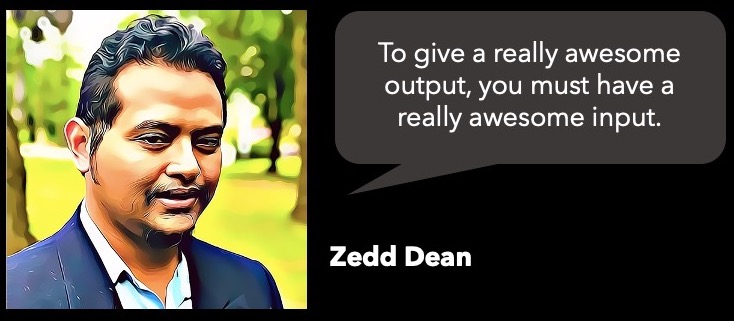
“To give a really awesome output, you must have a really awesome input.”
A swipe file is perhaps the most important tool for copywriting and content marketing.
So important, that it deserves its own video.
A swipe file is a file or folder that contains a collection of winning copy and contents.
It’s used mainly for inspiration and to study the ‘why’ behind the copy, so you can come up with your own winners.
From your swipe file, you can create your own templates and formulas as your experience adds up.
It can be digital or physical, soft copy or hard copy, desktop or mobile, or it can be in sync.
I personally have a digital swipe file that I can access through the cellphone and computer, and a hard copy swipe file, since I do copy for many genres.
Even if it’s a genre I’m not involved in, the underlying principles are worth studying.
Anyway, my digital swipe file is the main one. I always transfer the hardcopy and the mobile swipes to the digital swipe file, which is cloud-based.
Since this makes me write copy better and faster, I suggest you do the same.
Collect successful ads, copy and contents you see, hear or experience every day. And give special attention to the successful ones from the masters.
Organize them in genres, elements and even industries, or even authors.
Genres like salesletter, VSL, webinar, brochure, white paper, etc.
Elements like headline, sub-head, CTA, bullet list, opener, closing, PS,etc.
Industries like weight loss, dating, parenting, investment, real estate. This is also known as niche, market, or vertical, depending on what kind of digital marketer you’re talking to.
A good place to start is swipefile.com. This is compiled by an awesome guy named Neville Medhora. He’s a damn good copywriter, too. The founder of KopywritingKourse. Nev’s the wordsmith behind Noah Kagan and Appsumo back in the days. He made his swipe file public so people learn copywriting. Talk about leadership through example. Check out his swipe file. Check out his website.
Tip #7: Speak and transcribe. instead of writing or typing

“Copy is a direct conversation with the customer,” says the Advertising Hall of Famer Shirley Polykoff.
Most of us speak faster than writing or typing. So why waste time doing something time consuming when there’s a faster way?
Of course, this goes without saying, that some people write faster than they speak, like non-native speakers, for instance. If that’s you, you might want to stick with writing, although I think you should give this a try at least once.
The old school process goes like this:
First, you outline. This makes sure you don’t skip some important part, or add some unnecessary stuff.
Then, you record your voice as if you’re talking to your most ideal buyer/customer avatar. This makes your copy more human, more influential, and builds better rapport.
Next, you transcribe the recording. Find transcription services on Fiverr, on a nearby campus, or use some transcription software.
Finally, you edit the transcription to correct any error and make it more readable.
That’s the process when I first got started.
Now, I just go to Google Docs and use the voice typing function. This literally cut the time and effort in half. Voice type with your phone, or voice type with a computer. You can do this, too.
Just outline, voice type, and edit.
Tip #8: Write the easy part first
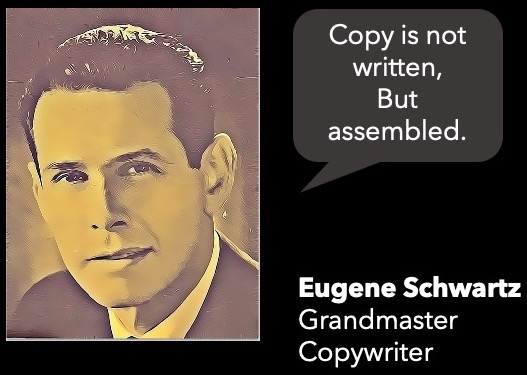
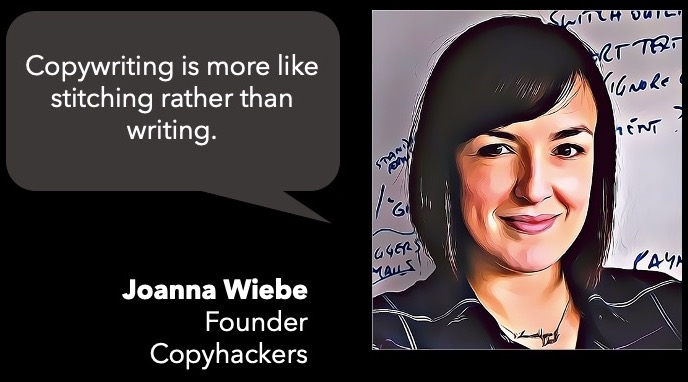
Grandmaster copywriter Eugene Schwartz stated that: “Copy is not written, but assembled.”
CopyHackers founder Joanna Wiebe mentioned that: “Copywriting is more like stitching rather than writing.”
Unlike live presentations, you don’t have to start writing from the very beginning.
Don’t know how to open? Start with the conclusion.
Don’t know how to conclude? Move on to point #1.
Can’t elaborate point #1 right now? Move on to point #2.
Or maybe point #5.
Wherever you start or finish, the finished draft won’t tell the difference.
In the end, your copy is one cohesive unit of marketing messages, branding assets, and/or sales arguments, regardless of what comes first or what comes last.
Tip #9. Finish the first draft fast. And tweak it later
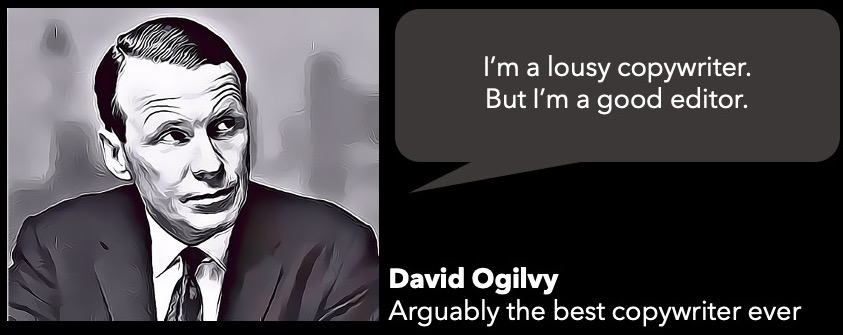
“I’m a lousy copywriter, but I’m a good editor,” said arguably the best copywriter ever live and crazy rich dude David Ogilvy.
Are you trying to create a masterpiece in one sitting? Stop dreaming.
In copywriting, the magic happens in the editing.
But before you make the magic happen, you need to build that base first. And that base is your first draft.
The first draft is almost always not good enough. That’s why you have to incubate and edit. And because it’s almost always not good enough, don’t spend too much time doing it.
Because it’s the first draft, it doesn’t have to be perfect. You don’t need to have the most on-point, articulate, or entertaining write-up.
As long as you have all the gist in place, and you got everything in the outline covered, it’s good enough.
Think beta version. Still a lot of room for improvement.
Complete the first draft fast. Give yourself some time to incubate. Tweak it later using an appropriate copywriting checklist.
Tip #10. Quit guessing and keep on testing
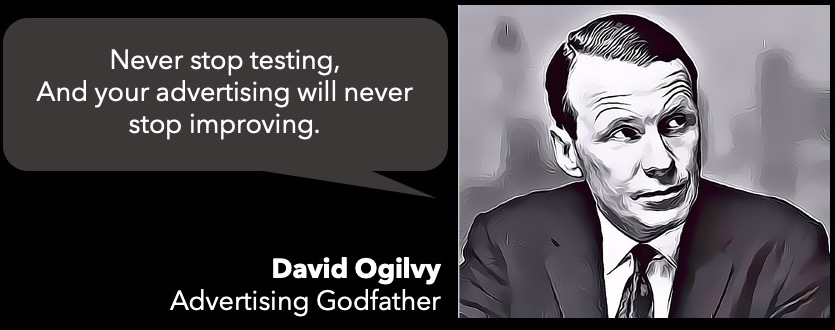
Advertising Godfather and the original Mad Man David Ogilvy once said: “Never stop testing, and your advertising will never stop improving.”
The worst thing about copywriting:
You’ll never know 100% what works and what doesn’t.
The best thing about copywriting:
You’ll never know 100% what works and what doesn’t.
This means you don’t need to spend hours, days, weeks, or months just guessing, second-guessing, and third guessing your copy.
The surest-fire way to know if the copy is good is by testing, and the surest-fire way to know how to improve is by split-testing.
Testing is when you send a small amount of traffic to the copy, or send the ad to a small number of prospects, instead of spending your whole ad budget in one go.
Split-testing is when you test 2 or more versions of your ad or copy in one testing campaign at the same time.
For example, instead of sending 100 prospects to the same sales page, 50 of them go to Version A and 50 to Version B (first prospect to A, second prospect to B, third prospect to A, forth to B, and so on and so forth).
This is the most accurate way of testing so far…
…because if you send some traffic to a Version A in the morning, and another bunch to B in the evening, people are in a different mood at a different time of the day.
And if you send half of the traffic to Version A and another half tomorrow to B, people’s mood and behavior differ from day to day.
This goes the same with different months and different years.
So split-testing is the most accurate.
The simplest form of this is AB testing, where you test only one component with 2 variables, like the sales pages are totally the same, except for one with Headline A and one with Headline B.
The more complicated split-testing is multivariate and/or multicomponent, where you have let’s say 5 different headlines, 5 different CTAs, plus 5 different images, and so on.
If you’re a beginner and/or with a low budget, you’re better off with AB testing, and if you’re already used to split-testing, use multivariate and multi-component to save time.
To split-test ads, you can do so on most ad platforms (FB ads, InstaAds, Adwords, etc.).
To split-test the sales page/video, you can do so with top web page builders (Thrive, Divi, ClickFunnels, LeadPages, ProfitBuilder, etc.)
Try and adjust, and scale it up the best way you can. You may take a few rounds of split-testing till you hit a home run.
This is the true epitome of learning while earning.
Conclusion:
Still watching?
You’re awesome.
You’re the selected few who have what it takes to win in this game. Give yourself a pat on the back.
To recap, here’s how you quickly craft really awesome copy so far:
- Do your research first.
- Start with an outline.
- Use proven formulas.
- Use proven tools.
- Use proven templates.
- Build your own swipe file (and make full use of it).
- Speak and transcribe (instead of typing or writing).
- Write the easy part first.
- Finish the first draft fast (and tweak it later.
- Quit guessing, and keep on testing.
I have 9 more power tips to go. But this video is already too long for most people to process.
Coz let’s face it. Since the dawn of the internet era, human’s attention span has been steadily decreasing. Now even the goldfish have better attention span than most humans.
Anyway, the 10 tips mentioned earlier are mostly technical, while the next 9 tips will be tactical and strategic.
Yes. Proper technique is crucial. But techniques alone won’t let you go that far.
To really nail it with your copy, you have to be tactical and strategic too. This will only amplify your copy’s impact.
And you sure don’t want to miss out, cause if your competition gets more strategic, you’re toast, and you’ll lose a big chunk of the market share.
So you want to learn the 9 remaining power tips?
Like this video and type down, “We Want More,” in the comment below.
If you haven’t subscribed yet, hit the subscribe button and the bell icon.
Because I’m planning to share those 9 tactical and strategic tips very soon, and you don’t wanna miss out.
In the meantime, be sure to put the 10 earlier tips to practice. Appreciate if you share your experience practicing ‘em in the comment below.
Thanks for reading. Till then. Work it till you make it!

